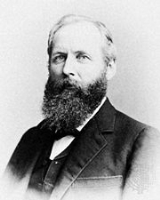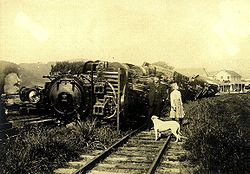
Grove Karl Gilbert
Encyclopedia
Grove Karl Gilbert known by the abbreviated name G. K. Gilbert in academic literature, was an American
United States
The United States of America is a federal constitutional republic comprising fifty states and a federal district...
geologist
Geologist
A geologist is a scientist who studies the solid and liquid matter that constitutes the Earth as well as the processes and history that has shaped it. Geologists usually engage in studying geology. Geologists, studying more of an applied science than a theoretical one, must approach Geology using...
.
Gilbert was born in Rochester, New York
Rochester, New York
Rochester is a city in Monroe County, New York, south of Lake Ontario in the United States. Known as The World's Image Centre, it was also once known as The Flour City, and more recently as The Flower City...
and graduated from the University of Rochester
University of Rochester
The University of Rochester is a private, nonsectarian, research university in Rochester, New York, United States. The university grants undergraduate and graduate degrees, including doctoral and professional degrees. The university has six schools and various interdisciplinary programs.The...
. In 1871, he joined George M. Wheeler's geographical survey as its first geologist.
Rockies geologist

John Wesley Powell
John Wesley Powell was a U.S. soldier, geologist, explorer of the American West, and director of major scientific and cultural institutions...
Survey of the Rocky Mountain
Rocky Mountains
The Rocky Mountains are a major mountain range in western North America. The Rocky Mountains stretch more than from the northernmost part of British Columbia, in western Canada, to New Mexico, in the southwestern United States...
Region in 1874, becoming Powell's primary assistant, and stayed with the survey until 1879. During this time he published an important monograph, The Geology of the Henry Mountains
Henry Mountains
The Henry Mountains are located in the southeastern portion of the U.S. state of Utah and run in a generally north-south direction, extending over a distance of about 30 miles . They were named by John Wesley Powell in honour of Joseph Henry, the first secretary of the Smithsonian Institution. The...
(1877). After the creation of the U.S. Geological Survey in 1879, he was appointed to the position of Senior Geologist and worked for the USGS until his death (including a term as acting director).
Gilbert published a study of the former ancient Lake Bonneville
Lake Bonneville
Lake Bonneville was a prehistoric pluvial lake that covered much of North America's Great Basin region. Most of the territory it covered was in present-day Utah, though parts of the lake extended into present-day Idaho and Nevada. Formed about 32,000 years ago, it existed until about 14,500 years...
in 1890 (the lake existed during the Pleistocene
Pleistocene
The Pleistocene is the epoch from 2,588,000 to 11,700 years BP that spans the world's recent period of repeated glaciations. The name pleistocene is derived from the Greek and ....
), of which the Great Salt Lake
Great Salt Lake
The Great Salt Lake, located in the northern part of the U.S. state of Utah, is the largest salt water lake in the western hemisphere, the fourth-largest terminal lake in the world. In an average year the lake covers an area of around , but the lake's size fluctuates substantially due to its...
is a remnant. He named that lake after the army captain Benjamin L.E. de Bonneville
Benjamin Bonneville
Benjamin Louis Eulalie de Bonneville was a French-born officer in the United States Army, fur trapper, and explorer in the American West...
, who had explored this region previously. The type of river delta
River delta
A delta is a landform that is formed at the mouth of a river where that river flows into an ocean, sea, estuary, lake, reservoir, flat arid area, or another river. Deltas are formed from the deposition of the sediment carried by the river as the flow leaves the mouth of the river...
that Gilbert described at this location has since become known to geomorphologists as a Gilbert delta.
Meteor Crater
In 1891 in one of the most controversial moves of his career, he proclaimed that Meteor CraterMeteor Crater
Meteor Crater is a meteorite impact crater located approximately east of Flagstaff, near Winslow in the northern Arizona desert of the United States. Because the US Department of the Interior Division of Names commonly recognizes names of natural features derived from the nearest post office, the...
in Arizona (then referred to as Coon Butte) was the result of a volcanic steam explosion
Maar
A maar is a broad, low-relief volcanic crater that is caused by a phreatomagmatic eruption, an explosion caused by groundwater coming into contact with hot lava or magma. A maar characteristically fills with water to form a relatively shallow crater lake. The name comes from the local Moselle...
rather than an impact of a meteorite
Meteorite
A meteorite is a natural object originating in outer space that survives impact with the Earth's surface. Meteorites can be big or small. Most meteorites derive from small astronomical objects called meteoroids, but they are also sometimes produced by impacts of asteroids...
. Gilbert had based his conclusions on a belief that for an impact crater, the volume of the crater including the meteorite should be more than the ejected material on the rim and also a belief that if it was a meteorite then iron should create magnetic anomalies. Gilbert's calculations showed that the volume of the crater and the debris on the rim were roughly equal. Further there were no magnetic anomalies. Gilbert argued that the meteorite fragments found on the rim were just "coincidence." Gilbert would publicize these conclusions in a series of lectures in 1895. Subsequent investigations would reveal that it was in fact a meteor crater. Ironically, Gilbert would be among the first to say that the moon's craters were caused by impact events rather than volcanos.
Geomorphology

Harriman Alaska Expedition
In 1899, wealthy railroad magnate Edward Harriman arranged for a maritime expedition to Alaska. Harriman brought with him an elite community of scientists, artists, photographers, and naturalists to explore and document the Alaskan coast...
in 1899. Two weeks after the 1906 San Francisco earthquake
1906 San Francisco earthquake
The San Francisco earthquake of 1906 was a major earthquake that struck San Francisco, California, and the coast of Northern California at 5:12 a.m. on Wednesday, April 18, 1906. The most widely accepted estimate for the magnitude of the earthquake is a moment magnitude of 7.9; however, other...
, Gilbert took a series of photographs documenting the damage along the San Andreas fault from Inverness to Bolinas.
Gilbert is considered one of the giants of the sub-discipline of geomorphology
Geomorphology
Geomorphology is the scientific study of landforms and the processes that shape them...
, having contributed to the understanding of landscape evolution, erosion
Erosion
Erosion is when materials are removed from the surface and changed into something else. It only works by hydraulic actions and transport of solids in the natural environment, and leads to the deposition of these materials elsewhere...
, river incision and sediment
Sediment
Sediment is naturally occurring material that is broken down by processes of weathering and erosion, and is subsequently transported by the action of fluids such as wind, water, or ice, and/or by the force of gravity acting on the particle itself....
ation. Gilbert was a planetary science
Planetary science
Planetary science is the scientific study of planets , moons, and planetary systems, in particular those of the Solar System and the processes that form them. It studies objects ranging in size from micrometeoroids to gas giants, aiming to determine their composition, dynamics, formation,...
pioneer, correctly identifying lunar craters as caused by impacts, and carrying out early impact-cratering experiments. Gilbert was one of the more influential early American geologists.
Awards
He won the Wollaston MedalWollaston Medal
The Wollaston Medal is a scientific award for geology, the highest award granted by the Geological Society of London.The medal is named after William Hyde Wollaston, and was first awarded in 1831...
in 1900 from the Geological Society of London. He was awarded the Charles P. Daly Medal
Charles P. Daly Medal
The Charles P. Daly Medal is awarded to individuals by the American Geographical Society "for valuable or distinguished geographical services or labors." The medal was established in 1902. This medal was originally designed by Victor D. Brenner, but the destruction of the dies caused the medal to...
by the American Geographical Society
American Geographical Society
The American Geographical Society is an organization of professional geographers, founded in 1851 in New York City. Most fellows of the society are Americans, but among them have always been a significant number of fellows from around the world...
in 1910. Gilbert was well-esteemed by all American geologists during his lifetime, and he is the only geologist to ever be elected twice as President of the Geological Society of America (1892 and 1909). Because of Gilbert's prescient insights into planetary geology, the Geological Society of America created the G.K. Gilbert Award for planetary geology in 1983. Gilbert's wide-ranging scientific ideas were so profound that the Geological Society of America published GSA Special Paper 183 on his research (Yochelson, E.L., editor, 1980, The Scientific Ideas of G.K. Gilbert, fourteen separate biographical chapters, 148 pages).
Crater
Impact crater
In the broadest sense, the term impact crater can be applied to any depression, natural or manmade, resulting from the high velocity impact of a projectile with a larger body...
s on the Moon
Moon
The Moon is Earth's only known natural satellite,There are a number of near-Earth asteroids including 3753 Cruithne that are co-orbital with Earth: their orbits bring them close to Earth for periods of time but then alter in the long term . These are quasi-satellites and not true moons. For more...
and on Mars
Mars
Mars is the fourth planet from the Sun in the Solar System. The planet is named after the Roman god of war, Mars. It is often described as the "Red Planet", as the iron oxide prevalent on its surface gives it a reddish appearance...
are named in his honor. Another crater on Mars was named after the ancient Lake Bonneville.
Publications
- "Report on the geology of the Henry mountains (1877)
- "Lake Bonneville" US Geological Survey Monograph No. 1. 1890. 438 p.
- "The Underground Water of the Arkansas Valley in Eastern Colorado" (1896)
- "Harriman Alaska Expedition, Volume 3: Glaciers and glaciation (1899)
- "The San Francisco Earthquake and Fire of April 18, 1906, and Their Effects on Structures and ..." (1907)
- "The transportation of débris by running water" US Geological Survey Professional Paper No. 86 (1914)
- "Bolinas" USGS photographs of San Andreas fault taken by Gilbert (1906)
- "http://www.amazon.com/dp/0292727194" S.J. Pyne, 1980, Grove Karl Gilbert - a great engine of research, University of Texas Press, 306 pages.
See also
- Gilbert (lunar crater)Gilbert (lunar crater)Gilbert is a large lunar crater that lies near the eastern limb of the Moon. Due to its location this feature appears foreshortened when viewed from the Earth, limiting the amount of detail that can be observed...
- Gilbert (Martian crater)Gilbert (Martian crater)Gilbert is a large Martian crater located in the south of the planet in the area of Promethei Terra. It is one of several large craters in the heavily pock-marked upland region. It was named in 1973 in honour of American geologist Grove K. Gilbert....
- G. K. Gilbert AwardG. K. Gilbert AwardThe G. K. Gilbert Award is presented annually by the Planetary Geology Division of the Geological Society of America for outstanding contributions to the solution of fundamental problems in planetary geology in the broadest sense, which includes geochemistry, mineralogy, petrology, geophysics,...
of the Geological Society of America

